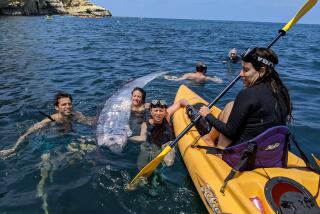Mission Bay Lab Hunts Secrets of Bass
SAN DIEGO — Once each month, the tan-and-white boat Pelican leaves the dock behind the Hubbs Marine Research Institute, next to Sea World at the southern end of Mission Bay.
As it cruises out into the middle of the bay, its crew of three begins to feed out a funnel-shaped nylon net from a platform near the stern. Weighted with a metal chain, the net sinks slowly to the bottom.
For five minutes, it is pulled along behind the boat. Then it is hauled up with a hydraulic winch.
“That’s when the fun starts,” said Donald Kent. “We get to pull all the stuff out.”
Stingrays, croakers, kelp bass and other denizens of the bay that have been snared in the net are carefully counted and measured, and the information is entered into a computer on board the Pelican. After that the fish are thrown back and the process begins again at a new location.
Kent explained the surveys are part of a larger effort to replenish stocks of white sea bass, a popular sport fish. In the late 1940s, 70,000 white sea bass were caught each year by California fishermen. But the bass have grown increasingly scarce, and since 1979 only about 1,000 a year have been landed.
In October, 1984, a bill sponsored by Assemblyman Larry Stirling created the Ocean Resources and Management Program, one of the goals of which is to bring about a greater abundance of white sea bass. One dollar from every sportfishing license and $10 from every commercial fishing license in Southern California goes toward supporting the program.
Much of that money--$240,000 of it this year--wound up at Hubbs, where Kent and colleague Richard Ford are perfecting techniques of raising juvenile white sea bass in large tanks. At the same time, they are studying Mission Bay to determine the best spots to eventually release the four-inch-long fish.
White sea bass are a type of croaker. They swim out of the ocean to spawn in estuaries and shallow bays in the spring. “The reason for that is these are very productive areas, full of the (plankton) they feed on,” Kent said.
So he and Ford are surveying the bay to find out where croakers of different ages live. At the same time, they are keeping track of temperatures, salinity and other information at seven different locations. By combining the two types of information, they hope to come up with ideal locations for juvenile sea bass.
Once the tank-raised fish are transplanted to the bay, they may hang around or they may move out, into kelp beds off the coast. But it will take them four to seven years to grow to a legal length of 22 inches--about a 15-pound fish. Kent and Ford plan to release their first white sea bass into Mission Bay in October, and if all goes well, fishermen might be hooking some of them by 1990 or ’91.
The two scientists have been raising fish and surveying the bay for a little more than a year and are just beginning to compile their information. But Kent noted that they have already identified some patterns in the distribution of fish.
“The shark-like rays and croakers seem to like the area near Fiesta Island. Near the bay’s entrance we find more turbot, kelp bass and sand bass,” he said.
“When you’re water skiing on it, it all looks the same. But down below, it’s not just a homogeneous habitat. There are a lot of different characteristics to it.”
More to Read
Sign up for Essential California
The most important California stories and recommendations in your inbox every morning.
You may occasionally receive promotional content from the Los Angeles Times.








